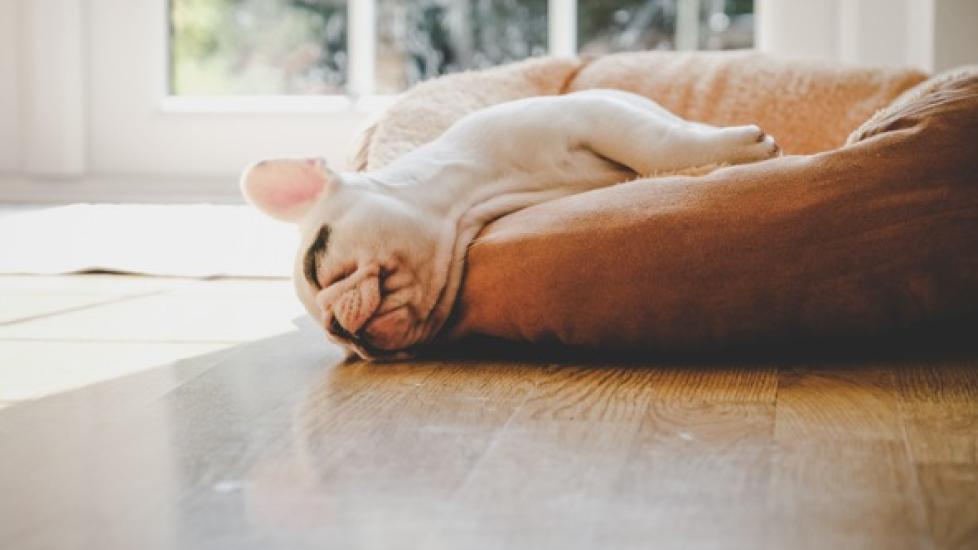Why Do Dogs Twitch in Their Sleep?
You may have noticed sudden, brief twitching at some point while your dog was sleeping and wondered if they were dreaming or even expressing some type of discomfort.
These involuntary movements—where a dog is twitching in their sleep—only occur during dream states and usually don’t last long. Twitching can happen anywhere in your dog’s body but commonly occurs in the legs, tail, or head. It may be accompanied by small vocalizations.
So is twitching just a normal part of dreaming, or are there times when you should worry?
Why Do Dogs Twitch in Their Sleep?
Dogs sleep an average of 12-14 hours each day. While they sleep, a dog’s brain processes information and experiences from the day through dreams. Twitching is often related to active dream cycles in the brain.
According to research by psychologist Stanley Coren, an average-size dog will dream about every 20 minutes, and these dreams will last about a minute. Larger breeds have fewer dreams that last longer—about every 45 minutes for 4 minutes. The opposite is true for smaller breed dogs; they will dream about every 10 minutes for up to 30 seconds.
Dogs experience the same dream stages as humans, including non-rapid eye movement (NREM), short-wave sleep (SWS), and rapid eye movement (REM). During the REM state, a dog’s eyes move around behind their closed eyelids, and the large body muscles are turned off so the dream is not physically acted out.
The part of the brain that contains these off switches is called the pons, which is part of the brain stem. In younger dogs, the pons may still be developing, while in older dogs it may be weakening from age. This is why twitching while sleeping occurs most commonly in younger and older dogs and less often in adult dogs.
The amount of twitching depends on how much these off switches inhibit muscle movement. Puppies spend more time in dream sleep than adult dogs because they need to process more information.
Dogs that sleep in a curled position will keep their muscles tensed and are less relaxed, which may cause them to twitch less than a dog that sleeps in a stretched-out position. Any outside stimulation from loud noises such as thunder, fireworks, or strange voices may partially awaken a sleeping dog and result in twitching as well.
Should You Wake Your Dog Up If They Twitch in Their Sleep?
If your dog sleeps next to you, they may unintentionally disturb your sleep with their sudden body movements. However, it is often advised to not awaken a dog that is twitching in their sleep unless they are clearly in distress.
A nightmare or night terror could be the cause of these involuntary movements, and they may wake up frightened. Try to avoid touching them so they don’t bite or scratch you as a result of being startled.
Instead, gently call your dog’s name until they respond. Speak calmly and reassure them that they are safe and secure after they wake up. While they appear to be pretty active in their sleep, dreaming dogs may be slow to awaken.
When Should You Be Concerned About a Dog Twitching in Their Sleep?
You should be concerned when the twitching interferes with your dog’s sleep. They may be unable to fall sleep or constantly awakened during sleep.
Another cause for concern is when the twitching becomes a full-body tremor, causing the body to go rigid or lasting longer than a brief spasm. In this case, there may be another explanation for the twitching, such as:
-
Seizure or other neurologic condition
-
Infection with parasites, bacteria, or viruses
-
Malnutrition
-
Low blood sugar
-
Low body temperature
-
Kidney and liver issues
-
Certain heart conditions
-
Poison ingestion
Ingesting topical or environmental pesticides or toxic foods may also cause twitches or tremors in dogs. If you suspect that your dog has had exposure to a toxin or has any other underlying medical condition, then an immediate veterinary exam is necessary for diagnosis and appropriate treatment.
What’s the Difference Between Twitching and a Seizure When a Dog is Sleeping?
During normal sleep, a dog’s body will be flexible and relaxed, and they will be breathing normally, with their eyes partially or completely closed. They should awaken easily and respond to voices.
Normal twitching usually occurs when a dog is lying on their side, paddling their paws, and possibly making little noises. You may notice irregular breathing when your dog starts twitching.
Seizures usually occur while dogs are awake. To determine whether twitching during sleep is due to a seizure, look for the following signs:
-
A stiffening of the body
-
Labored breathing
-
Eyes wide open but not reacting
-
Loss of consciousness with no response to your voice
-
Loss of control of urine and bowel movements
-
Foaming at the mouth
Dogs may temporarily act confused, disoriented, or dazed, and they may drool or pant after the seizure activity has ended.
Featured image: iStock.com/gollykim
